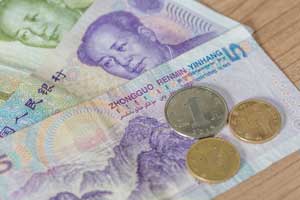China's Currency and Net International Income Flow

Since 2005, the United States has been a net borrower from the rest of the world, while China has been a net lender. However, the U.S. has had positive net international income in recent years, while China has had negative net income. Policy changes by China could change that.
The current account deficit the U.S. has been running implies that it has been importing more goods and services than it exports, thus exporting financial assets. China, on the other hand, has had a surplus and has been a net lender to the rest of the world. In effect, China has been financing the U.S. current account deficit by buying U.S. assets. (For figures showing the current account trends for both countries, see our Economic Synopses essay “Potential U.S. Consequences of China’s Capital Account Liberalization.”)
Despite the U.S. being a net borrower, its net income has been positive and increasing. This is because the return on its assets has been higher than the return it has been paying for its liabilities. China has seen the opposite: It has been paying a higher return from its liabilities than it has been receiving from its external assets. (Figures showing these trends are also available in our essay “Potential U.S. Consequences of China’s Capital Account Liberalization.”)
This discrepancy stems from the portfolios of each country:
- The U.S.’s assets are mostly portfolio equity and derivatives, and its liabilities are mostly low-risk (and, thus, low return) Treasuries.1,2
- China’s assets are mostly sovereign bonds from low-risk countries, and its liabilities are mostly foreign direct investment in China, which has more risk and pays a higher return.
However, China has been moving to expand the renminbi’s role in the global monetary system. These efforts may allow Chinese households, firms and institutional investors to diversify their portfolios and invest in international markets, including foreign direct investment and purchases of debt and equity portfolios. In turn, China could start earning higher returns than those available through holding safe but low-yield bonds.
As we concluded in our essay, this shift could reduce China’s currency risk if the U.S. dollar depreciates. If it also reduces official purchases of U.S. assets, the yield the United States must pay on those assets may increase slightly.
Notes and References
1 Lane, Philip R. and Milesi-Ferretti, Gian Maria. “The External Wealth of Nations Mark II: Revised and Extended Estimates of Foreign Assets and Liabilities, 1970-2004.”Journal of International Economics, November 2007, Vol. 73, Issue 2, pp. 223-50.
2 Gourinchas, Pierre-Olivier and Rey, Helene. “From World Banker to World Venture Capitalist: U.S. External Adjustment and the Exorbitant Privilege,” in Richard H. Clarida, ed., G-7 Current Account Imbalances: Sustainability and Adjustment. Chicago: University of Chicago Press, 2007, pp. 11-55.
Additional Resources
- Economic Synopses: Potential U.S. Consequences of China’s Capital Account Liberalization
- On the Economy: Are Emerging Economies Becoming More Resilient?
- On the Economy: How Has the Current Account of the U.S. Changed?
Citation
Ana Maria Santacreu and Usa Kerdnunvong, ldquoChina's Currency and Net International Income Flow,rdquo St. Louis Fed On the Economy, Aug. 1, 2016.
This blog offers commentary, analysis and data from our economists and experts. Views expressed are not necessarily those of the St. Louis Fed or Federal Reserve System.
Email Us
All other blog-related questions


